Feature Interview with Alan Oliver
February, 2020
1. How long have you been affiliated with Silloth on Solway Golf Club and in what capacities have you served over that time?
I have been very lucky to have joined Silloth when I was 10 years old and played all my golf here as a junior. I started working at the club in 1996, working in the professional’s shop. I worked there for 15 years and became a qualified PGA Professional. In 2011, I took over as the Club Secretary so I have been affiliated with Silloth for the last 30 years of my life.
As Club Secretary, my main duties include managing the day to day operations of the club, sales and marketing to attract visiting golfers and new members, and working with the team of staff at the golf club to give everyone who comes to Silloth the best experience possible.
2. Let’s talk about the evolution of the course, starting with David Grant. What does history tell us about his involvement as the original course architect?
David Grant was a golf professional from North Berwick who laid out the original course at Silloth in 1892. David was commissioned to design the course by the Marquis of Tweedale who was chairman of the North British Railway Company and owned the linksland to the south west of the docks. Tweedale was a member and recent past captain at North Berwick. The original golf course designed by David Grant measured 4,506 yards. In the photo below, the holes of today are lightly sketched on top of the Grant original (darker) routing.

3. Tell us about Willie Park Jr.’s impact on the course … does Silloth consider him the architect of record?
The first set of course changes happened between 1898 and 1902 when Willie Park Jnr lengthened some of the holes at Silloth, mainly on the front nine. Most of the changes consisted of the removal of some of the blind holes, the merging of others and he was also responsible for the introduction of the 4th and 5th holes. Willie Park Jnr’s changes took the length of the course to 5,804 yards. Willie Park Jnr does get recognised as the main architect and the course as we know it today was largely designed by him.

4. Some accounts show a record of Alister MacKenzie working at Silloth, please tell us about that.
In 1915 the committee invited Alistair MacKenzie to suggest a new layout. The advent of the Great War quickly put paid to any physical development but the project was resurrected afterwards with a projected cost of £1,500. With post war financial constraints, MacKenzie prepared his plans for approval at a general meeting of the club. Opinions were divided at the meeting and unfortunately the plans didn’t get approved amid concerns about the costs and fears of subscription increases. The club asked Dr. MacKenzie to proceed with some of the plans with a reduced budget of £500. Only a modest portion of his original plan was implemented involving only the construction of the third green and fourth tee which remain today. His initial plan would have seen major changes to the golf course and would have increased the length to 6,115 yards and some of the holes would have been relocated to what they are today.
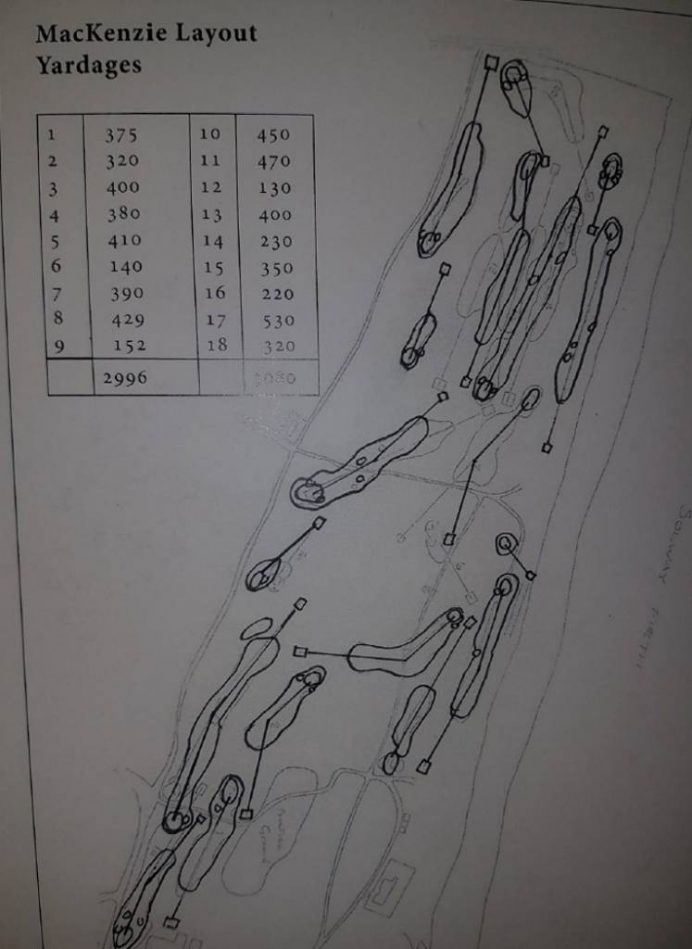
The photograph below is a telling one as you can see where the old 3rd green was situated. Willie Park Jnr had the 3rd green sited on the flat area at the base of the hill. MacKenzie moved the green some 60 yards back and left to today’s challenging location with a steep fall off left. In the process, MacKenzie moved the 4th tee to its current and improved position above the 3rd green.
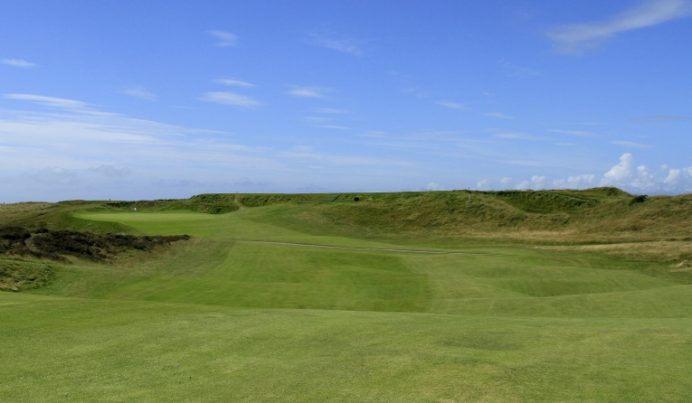
MacKenzie’s elevated green is the one in use today.
5. Have you witnessed any major changes in your 30 years there?
In the last 23 years there have been numerous small alterations to tees and bunkers but there have been just 3 main changes to the golf course in that time. The 5th hole was lengthened and a new green built about 40 yards behind the old green. This took what was a pretty easy par 5 and made it into a tougher test and a much better hole. The 11th fairway was rerouted to try to stop balls from being hit into a neighbouring static caravan park and the 18th tee was moved back about 40 yards which made this into a tough finishing hole.
6. Just three such changes in that span of time speaks well of the course’s design character. What has helped it stand the test of time?
The three course designers that have helped mould Silloth into what it is today have used the land in a superb way to create a wonderful golf course. There are a number of blind shots around the course, some as tee shots and a couple of approach shots. Whilst these may not be correct in the modern way of golf course design, they are a great feature of Silloth. I always find the natural undulations on the fairways to be a very good architectural feature, all of the fairways have beautiful undulations and form a big part of the challenge at Silloth.

The beautiful, lumpy rising fairway at #7 Battery.
7. What are some of Silloth’s more interesting architectural features?
A key part of the architecture of Silloth is the green sites. The green sites are situated in many different locations from large hollows on the 1st and 7th to form blind approach shots to plateaus elevated from the fairway on the 3rd and 16th.

Dell green site of #7 Battery.
The 4th green is situated on a ridge with 2 large hollows either side which forms, in my opinion, the best green site on the course. For first time visitors I would suggest they take notice of the green sites and appreciate them.
Also on the right hand side of the 2nd fairway and the left hand side of the 3rd fairway look at the sandy dune areas that are there. They frame the hole in a great way and offer both a natural and difficult hazard.
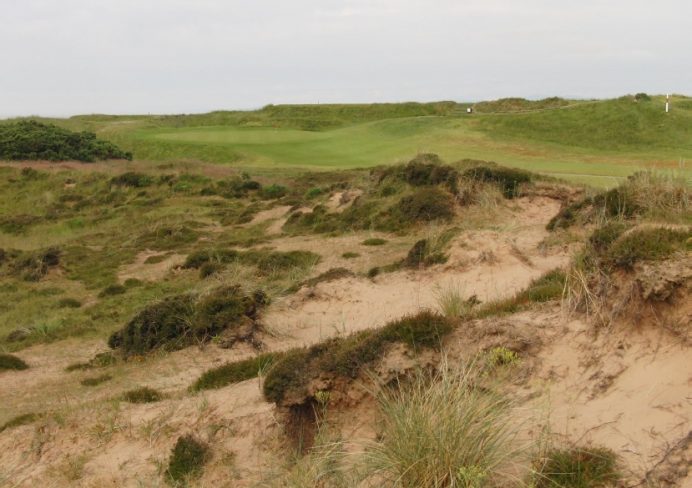
Nasty dune to the left of #3 Criffel.
8. Take us through a couple of the less heralded holes that a first time visitor might miss.
The 2nd hole is a lovely short par 4 of 315 yards and offers the player strategic options from the tee. The fairway sits at an angle from left to right so the options from the tee are to hit a tee shot of around 190-210 yards into the wider part of the fairway and leave approach shot of around 105-125 yards or hit a longer tee shot and leave a shorter approach shot. The danger in trying to hit the tee shot further is you bring the heather and gorse into play on the left hand side of the hole and the line you have to take from the tee brings the heather on the right of the hole much more into play too. The green is one of the more undulating on the course and flag positions on the front left are well guarded by a greenside bunker and a mound short of the green.
The 15th hole is a tough par 4 of 417 yards. The fairway is undulating and can be difficult to hit, especially in summer when the ball is bouncing around. The prevailing wind helps you on this hole and you can land your approach shot short of the green and allow it to run onto the green although any shots too short and left will kick left and into the green side bunker. The strategy on this hole is all about accuracy. You need to hit a solid tee shot followed by an accurate approach shot. There isn’t much room for error on this hole. While there are some holes that gather the ball this isn’t one of them. A tee shot hit down the left hand side can kick into the left rough and an approach shot hit short and slightly left will kick away from the green.
My top tip for playing strategy for first-timers at Silloth is this: When playing the course there is no trouble short and straight on any hole (apart from the short par 3 9th hole). All of the penalty on the holes is from green high and beyond so if you are ever in any trouble on the course, the best play is to hit it short of the green and you will always have a chance of getting up and down from there.
9. Sounds like good advice! Does a particular hole standout for being just darn fun to play?
This is a tough question as I could make a case for a lot of the holes as being the most fun to play, but if I had to pick one I think I would go for the 9th. This is one of our feature holes on the course and is a short postage stamp type par 3 of 131 yards and depending on the conditions can play anything from a sand iron to a 3 wood! There is no fairway on this hole just a tee, a green and lots of hazards so the challenge is hitting the green. It normally plays into the wind and is best played using a low knock down shot to control the ball knowing that any slight error in accuracy will result in you struggling to make a par.
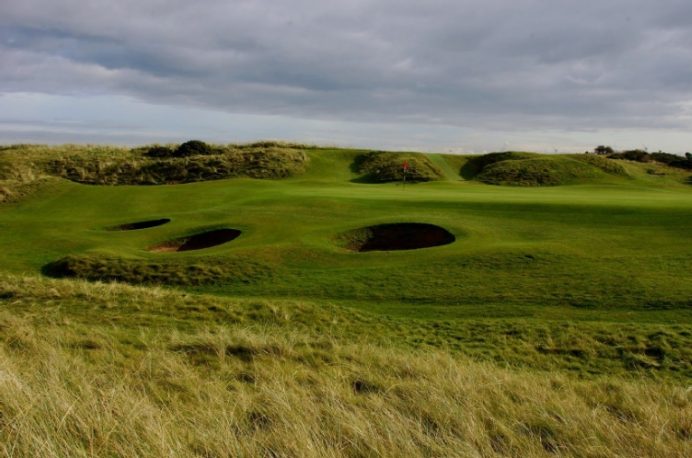
#9 The Manx looks less menacing in this back right view showing just three of the seven pot bunkers that encircle the target.
10. Describe three favourite shots and what makes them so.
Again this is a difficult question as narrowing this down to 3 isn’t easy. In no particular order:
1. The approach shot into the 3rd hole. The 3rd green is elevated and slopes from back right to front left with a big slope off the front of the green. Hitting this green and keeping the ball on the green is a challenge and requires a precise shot. Any shot landing on the front of the green or the left half of the green has a chance of rolling off and then getting up and down is quite tough.
2. The tee shot on the 5th hole. This par 5 is right down by the shore so the views over the Solway Firth are stunning. The fairway sits at an angle from right to left and is a very inviting drive. You can try to be brave and hit the tee shot across the corner slightly to leave a chance of reaching the green in 2 shots but this brings the left hand rough into play.
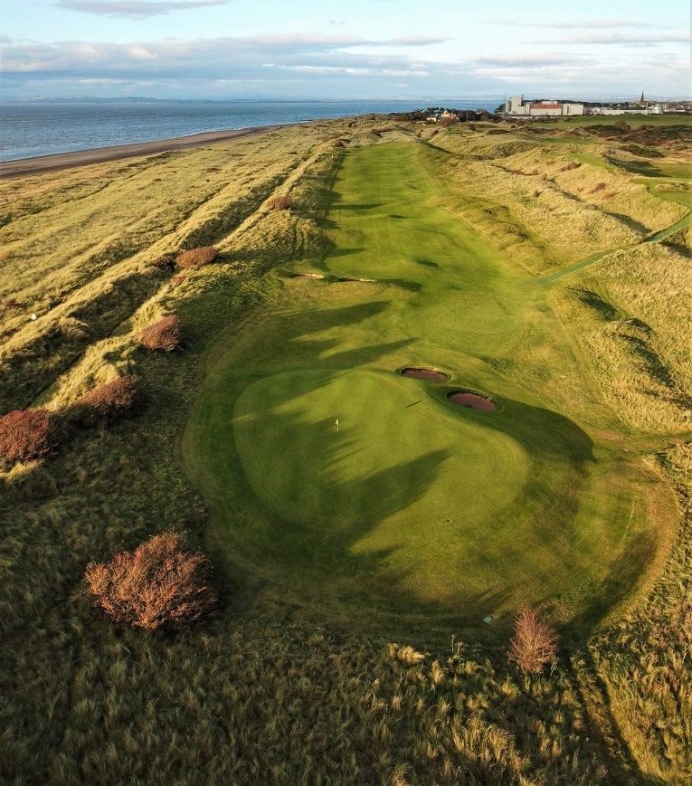
#5 Solway, as seen from behind with its tee well in the distance and off to the right.
3. The tee shot on the 9th hole. Standing on the 9th tee offers the best view on the golf course in my opinion. Looking over the sea across to the Scottish Fells on one side and the Lake District on the other it is a beautiful view. I mentioned the 9th hole as being the hole that is most fun to play and for that reason it is one of my favourite shots on the course.
11. The 4th green complex shares some similarities with the famous short 5th at Royal Worlington and Newmarket in Suffolk in that both greens occupy a long spine with abrupt fall-offs either side. Both are world class – Tell us about the challenges of Silloth’s 4th.
The 4th hole at Silloth goes under the radar a bit and is one of our best holes. It is a par 4 of 372 yards and poses challenges for every shot you will play. The tee shot is a blind shot over a large hollow with a long iron or fairway wood and must get over a ridge in the fairway to allow sight of the green for the approach shot. The green site is the best on the whole course and is a long narrow green with 2 steep hollows either side of the green. Missing the green means you are between 6-8 feet below the green level and have a daunting chip up to the green which if you’re not quite on your game can result in chipping back and forth over the green. This hole uses the natural contours in a stunning way to create a brilliant golf hole.

Note the length and narrowness of the green at #4 The Mill.
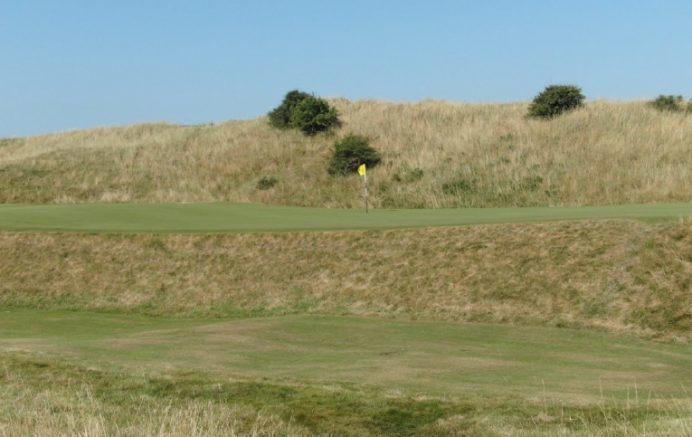
View from the right of #4 green. A recovery shot from the tight short grass below is no easy matter.

As seen from behind, only the straight miss will do.
12. Visitors probably leave the hole with more questions than answers after their initial round?
The approach shot to the 4th green is an all or nothing shot although it may not immediately appear so. It is one of the best shots on the golf course, you either hit the green or you’re in trouble. The only bail out on this shot is short and straight, anything green high and wide of the green is a potential card wrecker. The approach shot can be played in different ways and this adds to the wonderful challenge of the hole. As the hole normally plays downwind a shot can be landed short of the green and ran up the long narrow green, the difficulty with this is the area short of the green can throw the ball down into the green side hollows if the shot is slightly off centre. The slight upslope at the back of the green can be used to stop the ball from a shot flown straight onto the green but the difficulty with this is you have to fly the ball past the green side hollows to get there meaning the shot must be accurate. The challenge of getting your ball on the green and deciding which is the best way to do this is the beauty of links golf – your golfing brain is tested as you are required to play lots of different shots and the 4th hole is a great example of that.
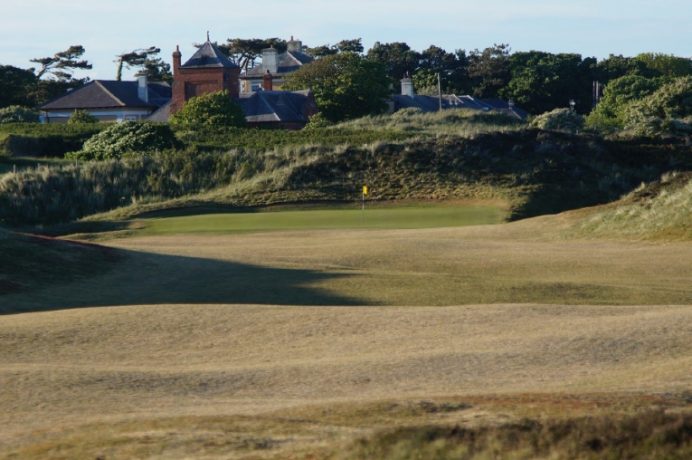
From the fairway, the first-timer’s attention is drawn to the narrowness of the lovely sited green without noticing the perils on both sides.
13. Is the recovery shot from either side of the 4th the hardest on the course? What other recovery shots are nearly as hard that the golfer would be well advised to avoid?
The recovery shot from either side of the 4th is one of the most daunting shots on the course if your short game is a little rusty. Many a player will chip the ball from one side across the green and down the other side. If the flag is at the back of the green, the shot is a little easier as you are aiming at the bank at the back of the green and the risk of chipping over the other side is much less.
On most other holes you would be able to find an area where the recovery shot was very difficult, but the 2 shots that stick out to me in particular as being the toughest are:
- The right hand side bunkers on the par 3 9th green where there are 3 bunkers. A tee shot landing on the right hand fringe will roll down into one of them. From inside any of these bunkers you are around 10-12 feet below the level of the green and you must hit a quite excellent bunker shot just to find the green.
- The other is either side of the par 5 13th green. This green is one of the hardest to hit at Silloth. Elevated at the course’s highest point, it throws balls off at all points of the green and your ball will end up in the rough some 6 feet below the level of the green. Playing from the rough to an elevated green exposed to any wind is inevitably a tough shot. Even a recovery shot of 20 yards or so can be a challenge to get to stay on the green.
14. Tell us about the unique juxtaposition of side-by-side par fives where the one at 511 yards is the #1 stroke index and the following at 507 yards is the #17.
The 13th and 14th holes are both par 5’s of around 500 yards from the back tees. Whilst they are very similar in distance, they are very different in how they play. The 13th hole is one of Silloth’s most noted holes. From the members competition tee it is 468 yards, has no bunkers, is a par 5 and is stroke 1. How is this so you may ask! Usually played into the prevailing wind the tee shot on the 13th is pretty straight forward into one of the widest fairways on the course. From there you have a 2nd shot over a heather bank into a narrowing fairway and then an approach shot uphill to a long narrow green that falls off all around. The green is probably the highest point of the course so you are fully exposed to any wind here, even hitting a sand iron into this green is daunting.

#13 Hogs Back, rising to the highest point on the course.
The 14th hole plays in the opposite direction and as it is normally played downwind is a much easier par 5 and offers a good birdie chance. The 14th hole has a tee shot over heather followed by a blind 2nd shot over large undulations in the fairway and approach shots can gather onto the green from both sides. Both of these holes are great fun to play as they are very different and pose unique challenges.
15. Please provide some insight regarding Silloth as a club and its membership.
The club has around 520 full playing members. The members of the club come from all over the UK as well as from the local area. As the annual subscriptions are only £550 per year and so this attracts people to become members from far and wide. The club attracts thousands of visiting golfers every year and the members are welcoming of these visitors. The club also has intermediate categories of membership aimed at attracting younger adults to the club as well as juniors and overseas membership.

Silloth’s handsome clubhouse was built in 1903.
16. What challenges do you face in your role of Secretary?
The biggest challenge facing me in my role now is retaining players and attracting new ones. There are lots of issues with people leaving the game and not being members of golf clubs any more so it is a challenge for us to maintain the member numbers and attract new members. In 2005 the number of full members at Silloth was 700, so in the last 15 years we have seen that number drop by nearly 200 members. Despite the fact that we have a world class golf course, we still find it difficult to maintain the member numbers. Fortunately, the income from visiting golfers subsidises this a lot and the number of visitors has increased in the last 5 years.
17. Being quite active in using social media and the internet to market the course is certainly a new component to being Secretary that didn’t exist 25 years ago. Tell us about it.
Sales and marketing is the most important area of my role now. Silloth used to be considered a hidden gem outside of the UK. Silloth probably still is seen as a hidden gem and I see it as my role to get rid of the hidden bit! There are so many ways of getting your message out to customers and a lot of golf clubs aren’t doing this well enough. The work we have done through social media and other channels is to try to increase the awareness of Silloth as a world class golf destination. A lot of visitors from America will naturally visit the main golfing areas like St Andrews, East Lothian and Southport where there are concentrations of great courses and understandably so. We are trying to get some of the visitors to travel a little bit away and come and play at Silloth where we are confident anyone who plays our course will want to play it again.
18. To our American readers of this interview, what information/insight might you like to share with them directly that they might not glean from any source other than yourself?
I fully appreciate that American golfers visiting the UK will often want to tick off the Open Championship courses and some of the other big names during their visit to our shores, but there is so much more to golf in the UK than just the big name courses. Silloth is unfortunate that it isn’t situated close to any of these big name courses so it gets overlooked by many. It is well worth the trip to play and we would love to welcome more American visitors to our wonderful links.
Thank you for your time and let me conclude our interview by saying I have never heard of a single person who went to Silloth and didn’t come away impressed.








